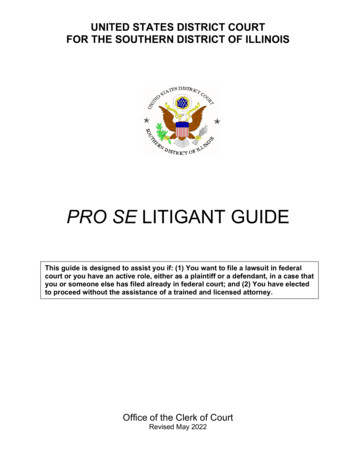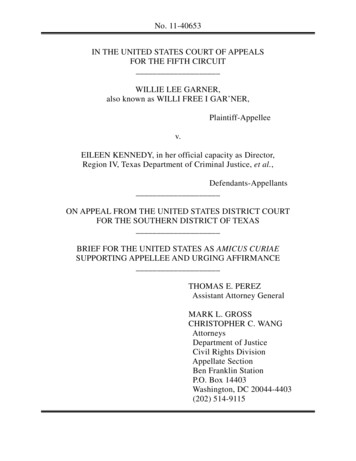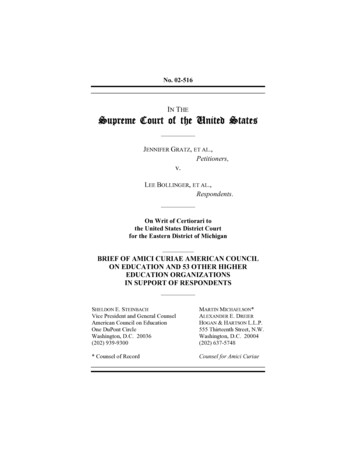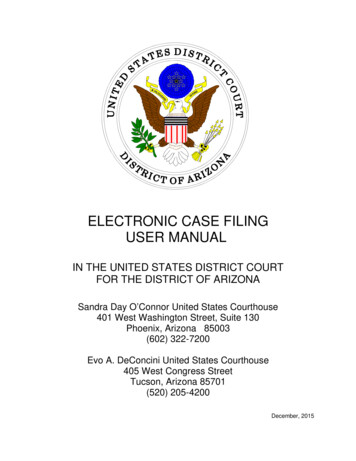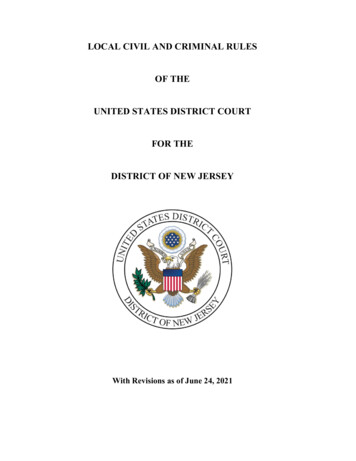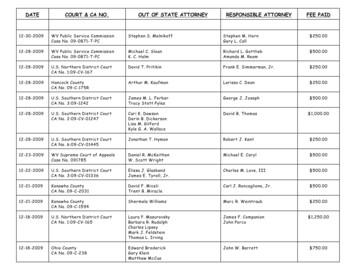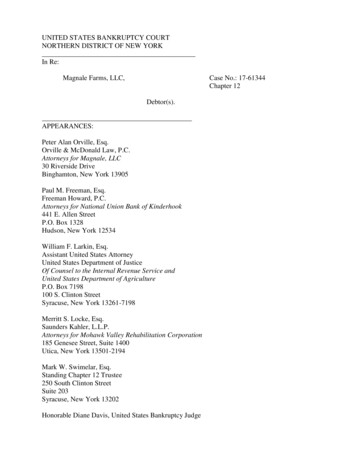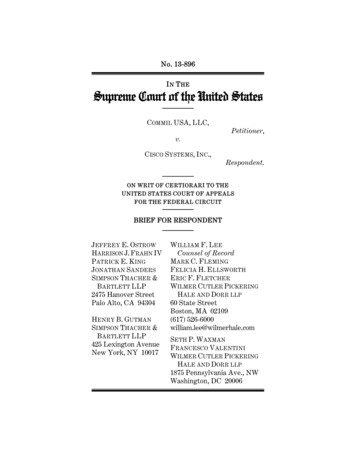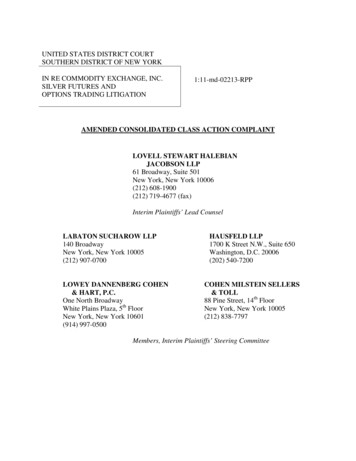
Transcription
UNITED STATES DISTRICT COURTSOUTHERN DISTRICT OF NEW YORKIN RE COMMODITY EXCHANGE, INC.SILVER FUTURES ANDOPTIONS TRADING LITIGATION1:11-md-02213-RPPAMENDED CONSOLIDATED CLASS ACTION COMPLAINTLOVELL STEWART HALEBIANJACOBSON LLP61 Broadway, Suite 501New York, New York 10006(212) 608-1900(212) 719-4677 (fax)Interim Plaintiffs’ Lead CounselLABATON SUCHAROW LLP140 BroadwayNew York, New York 10005(212) 907-0700LOWEY DANNENBERG COHEN& HART, P.C.One North BroadwayWhite Plains Plaza, 5th FloorNew York, New York 10601(914) 997-0500HAUSFELD LLP1700 K Street N.W., Suite 650Washington, D.C. 20006(202) 540-7200COHEN MILSTEIN SELLERS& TOLL88 Pine Street, 14th FloorNew York, New York 10005(212) 838-7797Members, Interim Plaintiffs’ Steering Committee
Plaintiffs complain, on knowledge as to their own conduct, of Defendants(see ¶¶22-29) as follows: 1SUMMARY OF ALLEGATIONS1.Unlawful conduct. (a) On June 26, 2007 and between March 17,2008 and October 27, 2010 (“Class Period”), Defendants combined, conspired andagreed to restrain trade in, fix, and manipulate prices of silver futures and optionscontracts traded in this District on the Commodity Exchange Inc. (“COMEX”)division of the New York Mercantile Exchange (“NYMEX”). Defendants therebyhave violated Section 1 of the Sherman Act, 15 U.S.C § 1.(b) Also during the Class Period, certain of the Defendants, includingJP Morgan (as defined in ¶¶22-25), have uneconomically and intentionally acted to1Plaintiffs’ information supporting their allegations made on information and belief include: (a)reports of statements by Commodity Futures Trading Commission (“CFTC”) Commissioner BartChilton that the silver market has been and is being manipulated; (b) public news reports aboutthe investigation by the CFTC of manipulation in the silver market; (c) news reports of JPMorgan’s recent decision to close trading operations; (d) reports showing the recent reduction inthe concentration of open interest in the silver futures contracts held by commercial firms; (e)reports of silver and gold prices and silver futures and silver options prices; (f) reports of tradingactivity, open interest and other aspects of silver futures, and silver options trading; (g) webcastsand statements of the March 25, 2010 Meeting of the CFTC to Examine Futures and OptionsTrading in the Metals Markets; (h) the following public reports: CFTC Commitment of TradersReports; CFTC Bank Participation Reports; Bank For International Settlements OTC DerivativesMarket Reports; Comptroller of the Currency Quarterly Reports On Bank Trading andDerivatives Activities; and the CFTC May 13, 2008 “Report on Large Short Trader Activity Inthe Silver Futures Market.”; and (i) other investigation including that reflected in specificallegations.
manipulate prices of COMEX silver futures contracts and options contracts, and tomonopolize the Relevant Market as defined in Count Four. Such conduct violatesSection 9(a) of the Commodity Exchange Act, 7 U.S.C § 13b, and Section 2 of theSherman Antitrust Act 15 U.S.C. §2.2.Purpose and Means. Defendants have effected their foregoingrestraint of trade and manipulation in order to profit themselves. Defendants havecaused declines in the price of COMEX silver, and COMEX options, and alsostabilized such prices through diverse means. These means include (a) a dominantand manipulative short position and market power manipulation; (b) repeatedmanipulative and uneconomic trades and trade manipulation; (c) false trades madeto facilitate a trade manipulation; and (d) other acts.3.Market Power Manipulation. (a) JP Morgan, gradually acquiredcontrol, between March 17, 2008 and August 2008, of an enormously large ounceshort position in COMEX silver futures and silver that previously was held by BearStearns. See Factual Allegations II.B.2 infra. This short position and JP Morgan’sexisting COMEX short silver positions gave JP Morgan substantial market powerin COMEX silver futures contracts.(b) For example, by August 15, 2008, JP Morgan held significantlymore net short COMEX silver positions than the next three largest traders on2
COMEX combined. JP Morgan frequently held 24-32% of the open interest in allCOMEX silver futures short contracts then trading. Moreover, JP Morgan alsosometimes held 30-40% of the short open interest in the important COMEX silverfutures contracts expiring in the “front” months.(c) As JP Morgan gradually acquired its total control of these largeCOMEX short positions, and thereafter, COMEX silver prices substantiallydecreased and substantially underperformed COMEX gold prices.(d) Conversely, when the control resulting from JP Morgan’sconcentrated short position in COMEX silver futures began to decline substantiallyafter the CFTC’s March 25, 2010 public hearing on manipulation, COMEX silverprices snapped back and substantially outperformed COMEX gold futures prices.4.Manipulative and Uneconomic Trades. (a) During the ClassPeriod, JP Morgan also made large manipulative trades that repeatedly causedsudden, unreasonable and artificial fluctuations in COMEX silver prices whichprofited JP Morgan. E.g., Factual Allegations II.B.1 and 4 infra.(b) One of these episodes occurred on August 14 and 15, 2008. JP Morgan’strades caused a very large decline of almost 1.41 per ounce, or approximately12%, in COMEX silver futures. This represented an approximately 220,000,000increase in the value of JP Morgan’s COMEX silver short positions.3
(c) Another of these occurred on June 26, 2007. See Factual AllegationsII.B.1 infra.4
(d) The plausibility of the allegations of silver manipulation on June 26,2007 and August 15, 2008 can be seen through an analysis of the silver marketincluding an analysis against the gold benchmark. This “benchmarking study”covers a four-year period from January 3, 2005 through December 31, 2008,containing 1,004 trading days. 2 As a benchmark for silver prices and tradingvolumes, the analysis incorporated similar measures for gold. The various resultsof the study, described more fully below, demonstrate that both price and volumemovements in silver futures around the options maturity dates of June 26, 2007 3and August 15, 2008 were unusual and statistically significant both compared totheir history as well as price and volume movements in gold. These findingssupport the allegations of manipulation on those days and inconsistent with anexplanation that the market was functioning normally and competitively on thosedates. In summary, the analysis finds:2The source of the futures data is CSI (csidata.com). CSI states:” CSI’s historical coverage includes all commoditymarkets gathered from over 80 futures exchanges traded worldwide. More than 99% of the markets in CSI’sinventory extend from the very first day of trading. The breadth of futures information includes, grains, currencies,world stock indices, metals, mercantiles, financials, energy and more.” CSI supplies yahoo.com and othercommercial users.3Silver futures options expiration occurs four business days prior to the end of the month preceding the optioncontract month. If the expiration day falls on a Friday or immediately prior to an Exchange holiday, expiration willoccur on the previous business day. s/silver contractSpecs options.html.5
The fall in spot and all futures silver prices on June 26, 2007 and August15, 2008 is highly unusual and highly statistically significant. Spot and futures silver prices declined significantly more than thedeclines in physical gold prices on both June 26, 2007 and August 15,2008. After taking into account contemporaneous moves in gold, the declines insilver prices on both June 26, 2007 and August 15, 2008 were stillstatistically significant. The decline is silver prices cannot be attributed to movements in gold. Regression analysis confirms that silver prices declined in an unusualfashion on these two days even after taking into account gold. The June 26, 2007 option expiration date was unique as compared toother expiration dates and it was characterized by an unusually largesilver price decline. This evidence is consistent with manipulation of the silver market onboth June 26, 2007 and August 15, 2008.6
In addition to a large price decline, silver futures also experienced higherrelative increases in trading volumes on both June 26, 2007 and August15, 2008 compared to its recent history as well as compared to tradingvolumes in gold futures during the same days. The results of regression analysis indicate that the increases in silvertrading volume cannot be explained by the normal relations between thetrading activity between silver and gold. The majority of the increase in trading volume during June of 2007 camedirectly from the July 2007 maturity contract. This evidence is consistentwith the explanation that the July 2007 maturity silver futures contractwas used to manipulate the silver prices around June 2007. The majority of the increase in trading volume during August 2008 camedirectly from the September 2008 maturity contract. This evidence isconsistent with the explanation that the September 2008 maturity silverfutures were used to manipulate the silver prices around August 2008.7
Although Plaintiffs do not believe that platinum and palladium should beused as benchmarks to silver, if these two metals are included in thestudies of gold as a combined composite benchmark, the results of theanalysis would also be robust. So, for example, regression analysisconfirms that silver prices declined in an unusual fashion on these twodays even after taking into account gold, platinum and palladium, and theresults of regression analysis indicate that the increases in silver tradingvolume cannot be explained by the normal relations between the tradingactivity between silver and the other precious metals – gold, platinum andpalladium.5.Large Uneconomic Sales To Depress Prices. Although June 26,2007 and August 15, 2008 were extraordinary days that stand out, Plaintiffs do notallege that JP Morgan’s large manipulative trades were limited to these verynotable dates. On the contrary, during the regime of JP Morgan’s dominantCOMEX short position, the COMEX silver futures market was plagued by thefollowing pattern of uneconomic conduct. Large sell orders hit the COMEX silverfutures market and moved COMEX prices down sharply. Factual AllegationsII.B.1, 3, 4, 5, and 7. This frequently happened during a time of day when therewas very low or no COMEX trading. This conduct is wholly contrary to the8
economic and rational investment conduct of selling gradually to receive the bestprice for a sale. This causes lower COMEX prices than one would receive if onegradually sold reasonable amounts especially during the more active trading timesof day.6.Selling large amounts in a compressed time period, especially duringan illiquid (or low trading) time of day, is a classic manipulative device tointentionally depress prices. These large uneconomic trades did cause the prices ofsilver in the COMEX market to be lower than they otherwise would have beenduring the Class Period.7.CFTC Commissioner Comment. (a) Such depressions of the pricesof COMEX silver futures through large uneconomic trades greatly benefited JPMorgan’s extraordinarily large COMEX short position.(b) Specific examples of these uneconomic trades were reported toCFTC Commissioner Bart Chilton during 2009-2010. This includes by a marketprofessional who is registered with the National Futures Association and has beena long time participant in the COMEX silver futures markets. Factual AllegationsII.B.5 infra.(c) Also, these types of trades were reported to the CFTC by otherpersons. Id. Plaintiffs further specifically allege that Commissioner Bart Chilton9
made public statements, including on October 26, 2010, to the effect that hebelieved there had been manipulation or related unlawful conduct in the COMEXsilver futures market.“I believe that there have been repeated attempts to influenceprices in the silver markets. There have been fraudulent effortsto persuade and deviously control that price. Based on what Ihave been told by members of the public, and reviewed inpublicly available documents, I believe violations to theCommodity Exchange Act (CEA) have taken place in silvermarkets and that any such violation of the law in this regardshould be prosecuted.”Bart Chilton, Statement at the CFTC Public Meeting on Anti-Manipulation andDisruptive Trading Practices, October 26, 2010. See ¶¶ 122-129 infra.(d) Many other instances of this large manipulative selling occurredthroughout the Class Period. Factual Allegations II.B.7.(e) Based on the facts and circumstances alleged herein, it is plausiblethat JP Morgan made many of these large uneconomic trades alleged in II.B.3, 5 or7.8.Saxo Combination. More than twenty five additional instances ofthis manipulative selling occurred following the appearance of a highly unusualfake trade on the Saxo Bank silver and FOREX trading Platform. See Exhibit A.JP Morgan and Deutsche Bank assisted Saxo in providing this trade platform.II.B.7 infra. However, this Saxo trade platform repeatedly published a fake trade10
through March 2010 that did not appear on trade platform e-Signal. See Ex. A.9.It was highly unusual for Saxo Bank to let a fake trade repeatedlyappear on the Saxo Bank platform. See II.B.7 Infra.10.In fact, the fake trade consistently appeared at the same time of day.This was between 5:45 p.m. and 6:00 p.m. when there was a lull in trading.11.Moreover, the price of the fake trade was far removed from theimmediate remainder of the other trades. Third, every fake trade involved a violentdown drop that appeared on the chart and immediately returned.12.The individual and cumulative effect of the more than twenty fiveplus COMEX price drops that occurred after the Saxo signal, was to causeCOMEX prices to be lower than they otherwise would have been.13.Coordination. Further, JP Morgan had other relationships. Forexample, JP Morgan’s silver trader who, when he was with Bear Stearns, helpedcreate the large COMEX short position, had joined JP Morgan by June or July2008. After joining JP Morgan, this trader then regularly communicated with thehead silver traders at HSBC. See II.B.2 and 3.14.“During-After” Comparisons. (a) During the Class Period, fromMarch 17, 2008 until March 25, 2010, when the CFTC held a hearing related to themanipulation of COMEX silver futures prices, COMEX silver prices greatly11
underperformed COMEX gold prices; the price of COMEX gold increased byapproximately 9% but the price of COMEX silver futures decreased 17%. Butafter the threats by the public government hearing on March 25 to expose anyonemanipulating silver, and the subsequent announcement by JP Morgan alleged at¶87 hereafter this prior relationship dramatically reversed. Specifically, COMEXsilver prices increased by approximately 40% from March 25, 2010 to October 27,2010. No fundamental changes in supply or demand for silver, including industrialdemand, occurred during this time period. Gold prices increased by only 21%during this time period.(b) The foregoing “price signature” of manipulation is not explainableby any changes in supply and demand. This “price signature” directly results, atleast in substantial part, from the increase in JP Morgan’s COMEX short silverfutures positions and the increase in Defendants’ manipulative acts during theMarch 17, 2008 – March 25, 2010 period, followed by JP Morgan’s decrease in theconcentration of its large short position and additional reductions in JP Morgan’sunlawful activities in the COMEX silver market after the March 25, 2010 publicgovernment hearing on manipulation.15.As a direct result of Defendants’ unlawful conduct alleged herein, theprices of COMEX silver futures and options were artificial during the Class Period12
and Plaintiffs and members of the Class suffered losses, were injured in theirproperty, and suffered actual damages.JURISDICTION AND VENUE16.Silver is a “commodity” and is the “commodity underlying” silverfutures and options contracts traded on the COMEX, as those terms are definedand used in Section 1a(4) and 22 of the CEA, 7 U.S.C. §§ 1a(4) and 25(a)(1)(D),respectively.17.This action arises under Section 1 of the Sherman Act, 15 U.S.C. § 1,Sections 4 and 16 of the Clayton Act, 15 U.S.C. §§ 15 and 26, and Section 22 ofthe CEA, 7 U.S.C. § 25.18.This Court has jurisdiction under Sections 4 and 16 of the ClaytonAct, 15 U.S.C. §§ 15(a) and 26, Section 22 of the CEA, 7 U.S.C. 25, and 28 U.S.C.§§ 1331 and 1337.19.Venue is proper in this District pursuant to 15 U.S.C. §§ 15(a),pursuant to Section 22 of the CEA, 7 U.S.C. § 25, and 28 U.S.C. § 1391(b), (c) and(d). The Defendants transacted business in the Southern District of New York, theclaims arose in the Southern District of New York, and a substantial part of theevents or omissions giving rise to the claims occurred in the Southern District ofNew York. Defendants’ unlawful acts manipulated the prices of COMEX silver13
(sometimes, “silver”) contracts which were traded in this District in whichCOMEX is located, at One North End Avenue, New York, New York. As usedherein, COMEX silver contracts means COMEX silver futures contracts, andCOMEX options on such contracts.20.Defendants made use of the means and instrumentalities oftransportation or communication in, or the instrumentalities of, interstatecommerce, or of the mails in connection with the unlawful acts and practices andcourses of business alleged in this Complaint.PARTIES21.During the Class Period, the named Plaintiffs hereto transacted inCOMEX silver futures and options contracts and lost money and were injured intheir property as a result of Defendants’ unlawful conduct.a. Plaintiff Alan J. Antin transacted in COMEX silver futures andoptions contracts during the Class Period and was injured in his property as a resultof Defendants’ unlawful conduct. This includes losses on June 26, 2007 in the July2007 and September 2007 COMEX silver contracts, and on August 15, 2008 in theSeptember 2008 COMEX silver contract.14
b. Plaintiff Blackbriar Holdings, LLC transacted in COMEX silverfutures and options contracts during the Class Period and was injured in hisproperty as a result of Defendants’ unlawful conduct.c. Plaintiff CLAL Finance Mutual Fund Management, Ltd. transacted inCOMEX silver futures and options contracts during the Class Period and wasinjured in its property as a result of Defendants’ unlawful conduct.d. Plaintiff Steven B. Crystal transacted in COMEX silver futures andoptions contracts during the Class Period and was injured in his property as a resultof Defendants’ unlawful conduct.e. Plaintiff Steven B. Crystal Trustee for the Estate of Norman S. Crystaltransacted in COMEX silver futures and options contracts during the Class Periodand was injured in their property as a result of Defendants’ unlawful conduct.f. Plaintiff Crystal Investment Partners LLC transacted in COMEXsilver futures and options contracts during the Class Period and was injured in itsproperty as a result of Defendants’ unlawful conduct.g. Plaintiff Christopher DePaoli transacted in COMEX silver futures andoptions contracts during the Class Period and was injured in his property as a resultof Defendants’ unlawful conduct.15
h. Plaintiff Paul Feldman transacted in COMEX silver futures andoptions contracts during the Class Period and was injured in his property as a resultof Defendants’ unlawful conduct. This includes losses on August 15, 2008 in theDecember 2008 COMEX silver contract.i. Plaintiff Gamma Traders I, LLC transacted in COMEX silver futuresand options contracts during the Class Period and was injured in its property as aresult of Defendants’ unlawful conduct.j. Plaintiff Rebecca A. Hougher transacted in COMEX silver futures andoptions contracts during the Class Period and was injured in her property as aresult of Defendants’ unlawful conduct.k. Plaintiff Dr. Robert Hurt transacted in COMEX silver futures andoptions contracts during the Class Period and was injured in his property as a resultof Defendants’ unlawful conduct.l. Plaintiff Paul D. Kaplan transacted in COMEX silver futures andoptions contracts during the Class Period and was injured in his property as a resultof Defendants’ unlawful conduct.m. Plaintiff Gordon Kost transacted in COMEX silver futures andoptions contracts during the Class Period and was injured in his property as a result16
of Defendants’ unlawful conduct. This includes losses on August 15, 2008 in theDecember 2008 COMEX silver contract.n. Plaintiff Teresa Kuhn transacted in COMEX silver futures and optionscontracts during the Class Period and was injured in his property as a result ofDefendants’ unlawful conduct.o. Plaintiff Shawn Kuo transacted in COMEX silver futures and optionscontracts during the Class Period and was injured in his property as a result ofDefendants’ unlawful conduct.p. Plaintiff Carl F. Loeb transacted in COMEX silver futures and optionscontracts during the Class Period and was injured in his property as a result ofDefendants’ unlawful conduct.q. Plaintiff Kevin J. Maher transacted in COMEX silver futures andoptions contracts during the Class Period and was injured in his property as a resultof Defendants’ unlawful conduct.r. Plaintiff Eric Nalven transacted in COMEX silver futures and optionscontracts during the Class Period and was injured in his property as a result ofDefendants’ unlawful conduct.17
s. Plaintiff J. Scott Nicholson transacted in COMEX silver futures andoptions contracts during the Class Period and was injured in his property as a resultof Defendants’ unlawful conduct.t. Plaintiff Robert Nepo transacted in COMEX silver futures and optionscontracts during the Class Period and was injured in his property as a result ofDefendants’ unlawful conduct. This includes losses on June 26, 2007 in the July2007 COMEX silver contract.u. Plaintiff Marlene Stulbach transacted in COMEX silver futures andoptions contracts during the Class Period and was injured in her property as aresult of Defendants’ unlawful conduct.v. Plaintiff Keith Wagner transacted in COMEX silver futures andoptions contracts during the Class Period and was injured in his property as a resultof Defendants’ unlawful conduct.w. Plaintiff Wayne W. Willetz transacted in COMEX silver futures andoptions contracts during the Class Period and was injured in his property as a resultof Defendants’ unlawful conduct.x. Plaintiff Vincent Yacavino transacted in COMEX silver futures andoptions contracts during the Class Period and was injured in his property as a resultof Defendants’ unlawful conduct.18
22.Defendant JP Morgan Chase & Co. is a Delaware financial holdingcompany with its principal place of business in New York, New York. JP MorganChase & Co. is a leading global financial services firm and one of the largestbanking institutions in the United States with 2.1 trillion in assets, 164.7 billionin stockholders' equity, and operations in more than 60 countries.23.Defendant J.P. Morgan Clearing Corp. ("JPMC"), formerly known asBear Stearns Securities Corp. is a Delaware corporation with its corporate officesin Brooklyn, New York. JPMC is a subsidiary of J.P. Morgan Securities Inc. whichis a wholly owned subsidiary of JPMorgan Chase & Co. JPMC is a registeredFutures Commission Merchant with the CFTC.24.Defendant J.P. Morgan Securities Inc. ("JPMS") is a Delawarecorporation with its principal place of business in New York, New York. JPMS is awholly owned subsidiary of JPMorgan Chase & Co. JPMS, through JPMC,provides securities and futures clearing, customer financing, securities lending andrelated services.25.Defendant J.P. Morgan Futures Inc. ("JPMFI") is a Delawarecorporation with its principal place of business in New York, New York. JPMFI isa U.S. futures commission merchant and wholly owned subsidiary of JPMorganChase & Co. JPMFI provides research, sales, execution and clearing services in19
futures and options across fixed income, equity, foreign exchange and commodityasset classes. JPMFI holds the U.S. accounts of JPMorgan Chase's global futuresand options business customers.26.Plaintiffs have entered into a tolling agreement with HSBC Holdingsplc ("HSBC Holdings"), HSBC Securities (USA) Inc. ("HSBC USA"), and HSBCBank USA, National Association ("HSBC NA"). They are not named asDefendants in this amended complaint.27.John Doe Defendants 1-10 are persons, whose identities are presentlyunknown to Plaintiffs, who performed, participated in, furthered, and/or combinedconspired or agreed with JP Morgan to perform the unlawful act alleged herein,including acting as JP Morgan’s broker in the restraint of trade, fixing of prices,and manipulation of silver futures and silver options traded on the COMEX.28.John Doe’s 11-20 are persons who manipulated or aided and abettedthe manipulation of COMEX silver futures prices as alleged herein.29.As used herein, Defendants refers to the John Doe Defendants and theJP Morgan Group Defendants. As used herein, JPMorgan Chase & Co., J.P.Morgan Clearing Corp., J.P. Morgan Securities Inc. and J.P. Morgan Futures Inc.are sometimes collectively referred to as “JP Morgan” or “JPM”20
FACTUAL ALLEGATIONSI.Background30.Wholly unlike the securities markets, in the commodity futures market(a) more than 99% of the contracts do not result in delivery and may remain openfor multi-month periods with no delivery of the commodity, and (b) at any giventime, one-half of the participants in the futures market are “short” and one-half ofthe participants are the buyers of a contract or “long”.A.Overview of COMEX Silver Futures and Options Contracts31.Silver futures contracts and silver options contracts are traded onCOMEX.32.COMEX, a division of the New York Mercantile Exchange(“NYMEX”), has been designated by the CFTC as a contract market pursuant toSection 5 of the CEA, 7 U.S.C. § 7. COMEX submits to the CFTC various rulesand regulations for approval through which COMEX designs, creates the terms of,and conducts trading in various precious metals futures and options contracts,including futures and options contracts for silver. COMEX is an organized,centralized market that provides a forum for trading silver futures and optionscontracts.21
33.COMEX provides standardized silver futures contracts with deliverydates commencing with the next calendar month and potentially extending as far as60 sequential months into the future depending upon the month in which thecontract was executed. Typically, there are approximately twenty COMEX futurescontracts trading at any given time. Trading is conducted for delivery during thecurrent calendar month; the next two calendar months; any January, March, May,and September falling within a 23-month period; and any July and Decemberfalling within a 60-month period beginning with the current month. The “soonest”two expirations are referred to as the “front” months, and are the most activelytraded months.34.A silver futures contract is an agreement to buy or sell a fixed amountof silver at a date in the future. The COMEX specifies the terms of trading,including the trading units, price quotation, trading hours, trading months,minimum and maximum price fluctuations and margin requirements.35.Trades of silver futures contracts on the COMEX have two “sides.”The “long” side represents the buyer of a contract who is obligated to pay for thesilver and take delivery. The “short” side represents the seller of a contract who isobligated to receive payment for the silver and make delivery. If a marketparticipant holds its position to the end of the settlement period for a silver futures22
contract, the market participant is obligated to “go to delivery.” That is to say,upon the settlement date, the “futures” contract for a particular month becomes apresent contractual obligation for the purchase and sale of the physical silver.Longs must take delivery and shorts must make delivery of 5,000 troy ounces percontract over the course of the contract month. The price for the silver that goes todelivery is the “settlement price” of the COMEX silver futures contract.36.Only a small percentage of all futures contracts traded each year onCOMEX and other exchanges result in actual delivery of the underlyingcommodities. Instead, traders generally offset their futures positions before theircontracts mature. For example, a purchaser of a silver futures contract can cancelor offset his future obligation to the contract market/exchange clearing house totake delivery of silver by selling an offsetting futures contract. The differencebetween the initial purchase or sale price and the price of the offsetting transactionrepresents the realized profit or loss.B.Short Option Positions37.There are two types of options, calls and puts. A call gives the holderof the silver option the right, but not the obligation, to buy the underlying silverfutures contract at a certain price, the strike price, up until some point in the future- options expiry. Conversely, the put gives the holder the right, but not the23
obligation, to sell the underlying silver futures contract at the strike price up untiloptions expiry. Puts are usually bought when the expectation is for falling prices; acall is usually purchased when the expectation is for rising prices. The price atwhich an option is bought or sold is the premium.38.There are various ways to use options to "go short," i.e., bet that theprice of silver will decrease. One can sell a futures contract, which confer upon theseller an obligation to deliver silver at a pre-specified date in the future at a prespecified price. One can also buy put options, which confers upon the buyer of theput option the right, but not the obligation, to sell silver to a buyer at a prespecified str
OPTIONS TRADING LITIGATION 1:11-md-02213-RPP . AMENDED CONSOLIDATED CLASS ACTION COMPLAINT LOVELL STEWART HALEBIAN JACOBSON LLP 61 Broadway, Suite 501 New York, New York 10006 (212) 608-1900 (212) 719-4677 (fax) Interim Plaintiffs' Lead Counsel LABATON SUCHAROW LLP HAUSFELD LLP 140 Broadway 1700 K Street N.W., Suite 650 .


